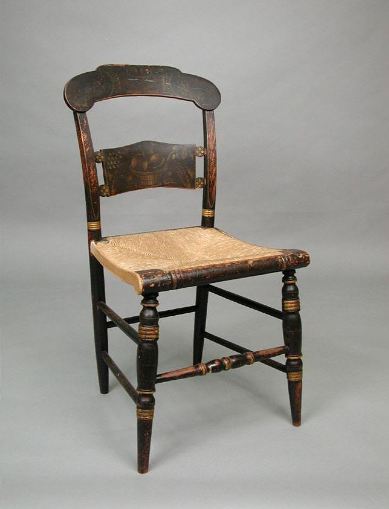By Anne Guernsey for Your Public Media
During the second quarter of the 19th century, “fancy chairs” were all the rage for middle-class American parlors and dining rooms. These emblems of social mobility were often called “Hitchcock chairs” after Lambert Hitchcock (1795-1852), the Yankee inventor who started the craze.

Side chair made by Lambert Hitchcock, 1825-1832 – Connecticut Historical Society, Gift of The Hitchcock Chair Co., Ltd
Making chairs and other wood furniture had always been a laborious job, as each part was handmade. Hitchcock made the process faster and easier by mass producing interchangeable chair parts. Originally from Cheshire, Hitchcock established a factory on the upper Farmington River in the town of Barkhamsted in 1819. The village that grew up around his factory was known as Hitchcocksville until 1866, when the name was changed to Riverton. Hitchcock manufactured all types of furniture: adult straight chairs and armchairs, smaller chairs for children, long benches with detachable front rails called “Cape Cod Rockers” or, invoking a then more common stereotype, “Mammy Benches.” His furniture was inexpensive and beautifully decorated with stencils filled in with oil paint or inexpensive metallic powder. Men made the chairs, children painted them, and women applied the stencils. Hitchcock and his family later relocated to Unionville (a section of Farmington), where he continued to make furniture. Despite the popularity of his furniture, Hitchcock was not a rich man. He actually went bankrupt multiple times, and when he died of “brain fever” in 1852, his assets were less than his liabilities.
In the 1940s, John Tarrant Kenney founded the much-beloved Hitchcock Chair Company,Ltd., in Riverton, continuing Lambert Hitchcock’s legacy. The Hitchcock Chair Company, Ltd. closed its doors in 2006, but the business has recently been revived a second time by Rick Swenson and Gary Hath, a pair of antique dealers from New Hartford.
Anne Guernsey, who holds a Master’s degree in Art History, was formerly the Manager of Institutional Advancement at the Connecticut Historical Society.
© Connecticut Public Broadcasting Network and Connecticut Historical Society. All rights reserved. This article originally appeared on Your Public Media.
Note: ConnecticutHistory.org does not edit content originally published on another platform and therefore does not update any instances of outdated content or language.









